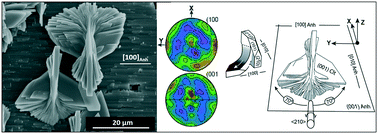Epitactic growth of celestite on anhydrite: substrate induced twinning and morphological evolution of aggregates†
Abstract
Epitactic crystal growth plays a main role in the development of mineral processes and in the synthesis of advanced materials. Celestite (SrSO4) forms epitactic overgrowths on anhydrite (CaSO4) (100), (010) and (001) surfaces upon interacting with Sr-bearing aqueous solutions. Two populations of differently oriented celestite crystals related by symmetry operators of substrate are identified on (001)Anh and (100)Anh anhydrite substrates by SEM observations and synchrotron X-ray diffraction analysis. Substrate-induced twins arise after the coalescence of individuals belonging to these populations. Progressing growth results in a marked morphological evolution of epitactic celestite, whose crystals undergo sustained branching and loss of co-orientation that result in the formation of sheaf-like aggregates, on (100)Anh, and swan-like aggregates, on (001)Anh. We relate this evolution to celestite growth in a Ca-rich environment due to continued anhydrite dissolution and incorporation of small amounts of Ca into celestite structure. This incorporation would induce lattice strain which would be released through the formation of dislocations. The regular arrangement of these dislocations in small-angle boundaries would result in progressive splitting, driving the evolution from celestite single crystals to aggregates. Sharp compositional gradients in the boundary layer could explain the anisotropic development that leads to the formation of the swan-like celestites.



 Please wait while we load your content...
Please wait while we load your content...